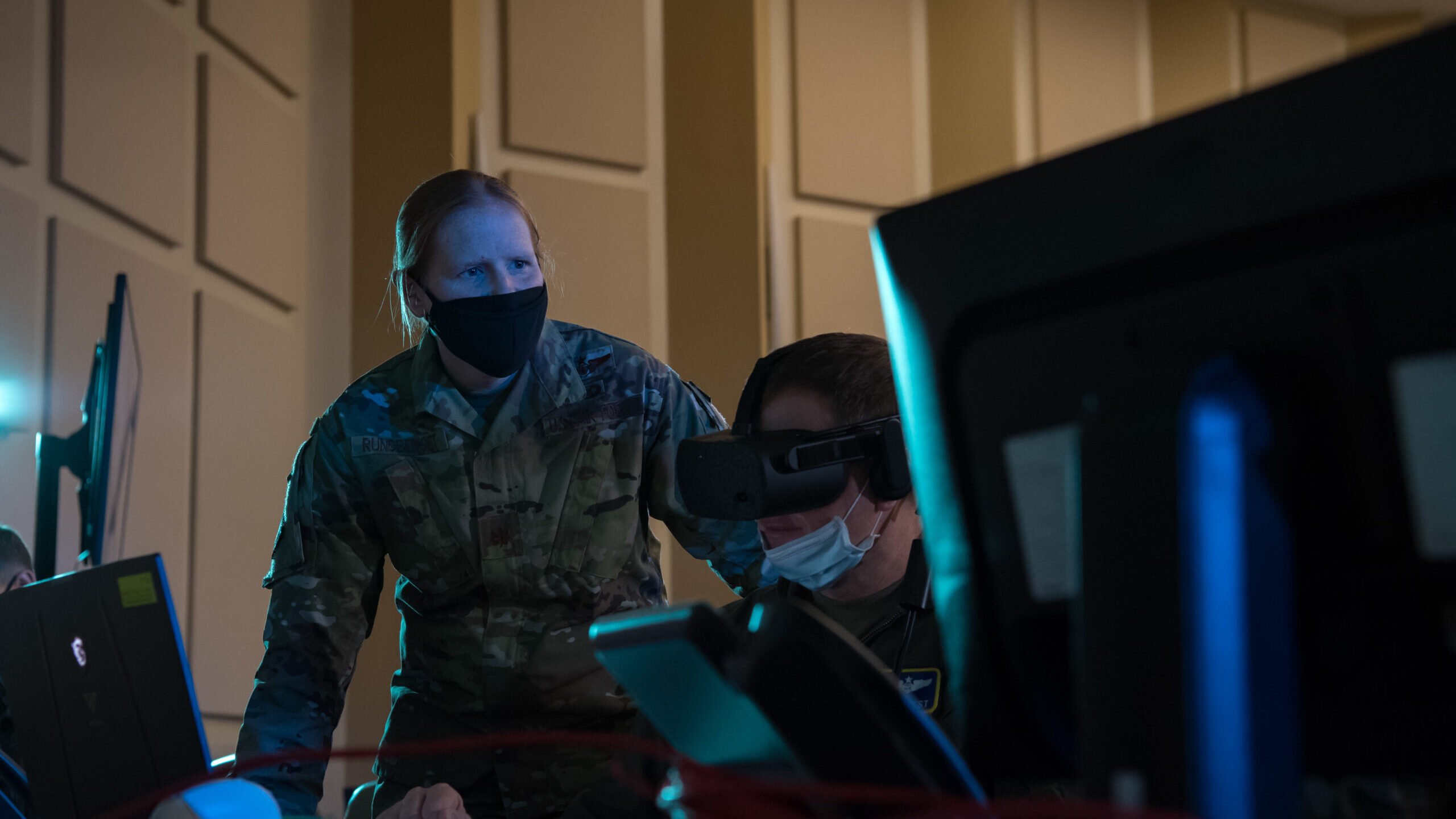
U.S. Air Force Major Erin Rundberget, team chief of targeting and effects from the 612th Air Operations Center, relay directions in support of the Advanced Battle Management System (ABMS) Onramp 2, Sept 2, 2020 at Joint Base Andrews, Maryland. (U.S. Air Force photo by Senior Airman Daniel Hernandez)
WASHINGTON — For the fourth time in the rocky history of the Advanced Battle Management System (ABMS), the Air Force is revamping its efforts to connect sensors and shooters from the air all the way up to space, unveiling a new framework that now represents the sum of the Department of the Air Force’s (DAF) contributions to the Pentagon’s Joint All Domain Command and Control (JADC2) initiative: the sprawling DAF Battle Network.
As described in recently released fiscal 2024 DAF budget request [PDF] documents, the DAF Battle Network is far more expansive than ABMS, involving dozens of different programs. It reflects the push by service Secretary Frank Kendall to ensure the DAF’s various JADC2-related efforts are more effectively unified, Brig. Gen. Luke Cropsey, the integrating program executive officer (PEO) charged with executing that task, said in an interview with Breaking Defense.
“The dynamic range of what’s required based on a mission that you have to do, defines what the Battle Network has to be capable of doing at any given point in time,” Cropsey explained, who said the ABMS portfolio still forms the “core” of that assignment.
Making JADC2 a reality poses a range of technical and operational problems, Cropsey said, and the Battle Network represents “the physical architecture, the product architecture, that’s needed” to address them.
According to Cropsey, the DAF’s contributions to JADC2 are now structured like this: At the top level is the Battle Network, which encompasses all JADC2 efforts. Under the Battle Network is what the Air Force calls the Command, Control, Communications and Battle Management (C3BM) Enterprise, a collection of roughly 50 programs and their PEOs across the Air Force and Space Force. The C3BM Enterprise, in turn, now includes ABMS, which is continuing to develop the digital infrastructure needed to enable the enterprise to connect to cloud-based command and control, like for a new Space Force effort to deploy satellite payloads able to detect and track moving targets on the ground.
Fielding all domain capabilities “is predicated on my ability to create the digital infrastructure that’s needed” for various platforms, sensors and other systems to be able to connect to a shared cloud environment, he said. He emphasized that those systems will not always be “high glitz, big ticket items” and must “actually function together at a system of systems level.”
The Battle Network concept — previously alluded to by top officials like Chief of Staff Gen. CQ Brown during a recent speech at the Air and Space Force Association’s Air Warfare Symposium — was introduced “to differentiate the fact that as an integrating PEO with architecture authorities, I now have a much more extensive set of authorities around the ability to direct the integration at the DAF level” after being tapped as the integrating PEO for C3BM efforts in September 2022, Cropsey said.
According to the FY24 budget documents, the service plans to request about $500 million for ABMS in FY24, more than twice what Congress enacted in FY23 but lower than the service’s previous projected request of $556 million. ABMS funding would then climb to $815 million in FY25 and $951 million in FY26, subsequently declining to $721 million in FY27 and $711 million in FY28. (There is not a similar figure for the Battle Network, whose funding is spread across the 50-odd projects.)
Cropsey said the service kept ABMS as a specific budget line item to reflect continuity with previous ABMS work, which included efforts like fielding tactical edge node capabilities on the KC-46 and future aircraft, and to illustrate his own “organic” budget. “When you look at the budget, the budget that you see listed under the ABMS [program element] is just that portion of the budget that I own as the owning PEO,” he said.
Cropsey came into the role, which Kendall called the “most difficult job I have ever given anybody by a wide margin,” after a series of difficulties with ABMS.
In 2019, the service chose Preston Dunlap as its first-ever chief architect to oversee ABMS development and lead a series of ABMS “Onramp” experiments. But following an April 2020 report from the Government Accountability Office and skepticism from lawmakers, Air Force officials changed course and put the Air Force Rapid Capabilities Office (RCO) in charge of acquisitions and integration, leaving Dunlap to manage Onramps. (The service’s then-acquisition chief said the timing of the change was not a direct result of congressional concerns.)
Lawmakers then halved the service’s ABMS funding request in FY21, forcing the cancellation of a planned Onramp with Australia. The Onramps were eventually abandoned altogether after Kendall directed the service to instead focus on concrete capability releases like the edge node planned for the KC-46. Dunlap resigned last year, and after Kendall indicated he was interested in implementing a structure that would foster greater integration for JADC2 efforts across the DAF, he appointed Cropsey as the integrating PEO for all C3BM programs.
“There is a singular individual with the rose pinned on him from the secretary when it comes to the integration of all the individual parts and pieces. That didn’t exist before, even underneath of the RCO,” Cropsey said. “The secretary is now looking at me directly, as the individual that’s responsible at the end of the day for making sure it all integrates.”
Overseeing integration for the DAF’s sundry JADC2 initiatives brings numerous challenges, Cropsey said, but a key is ensuring that engineers and operators remain in close contact as the physical and digital infrastructure of joint all domain operations is built out.
“The architecture cannot be done in abstraction from the problem that it’s designed to solve,” he said. “They have to stay very tightly linked.”






















